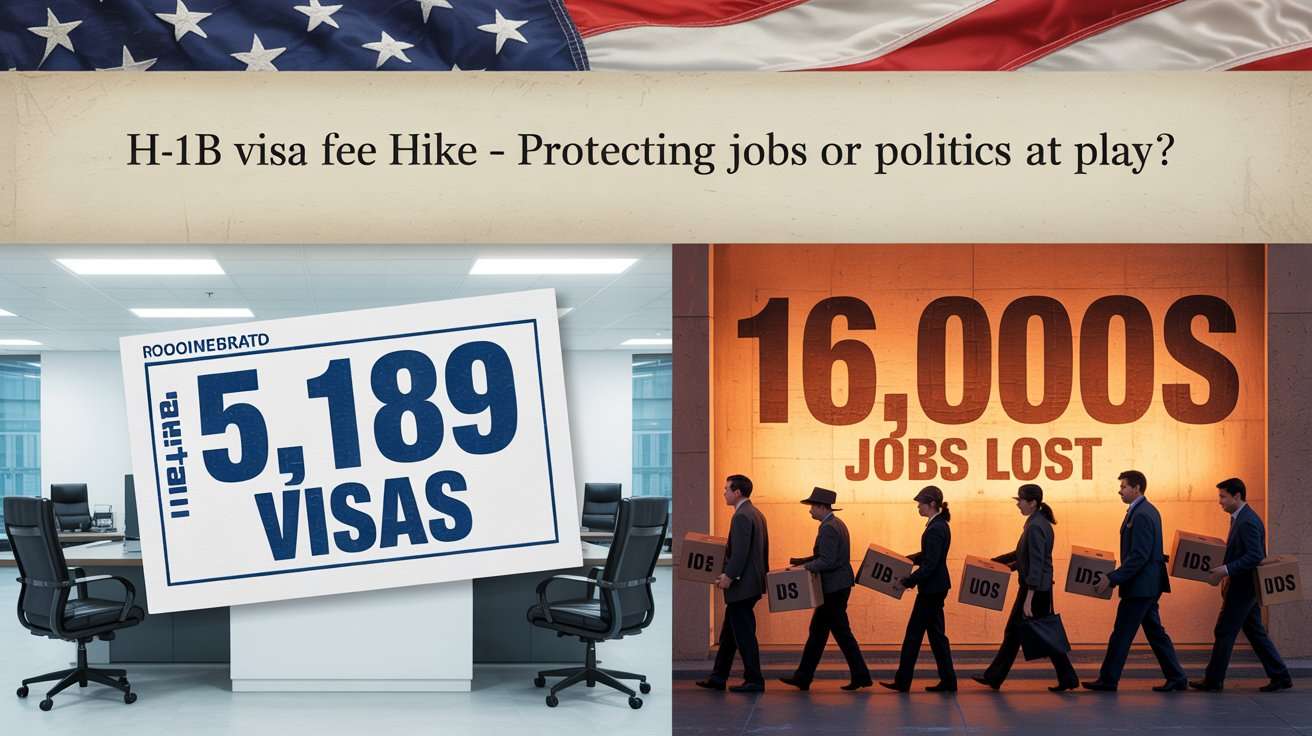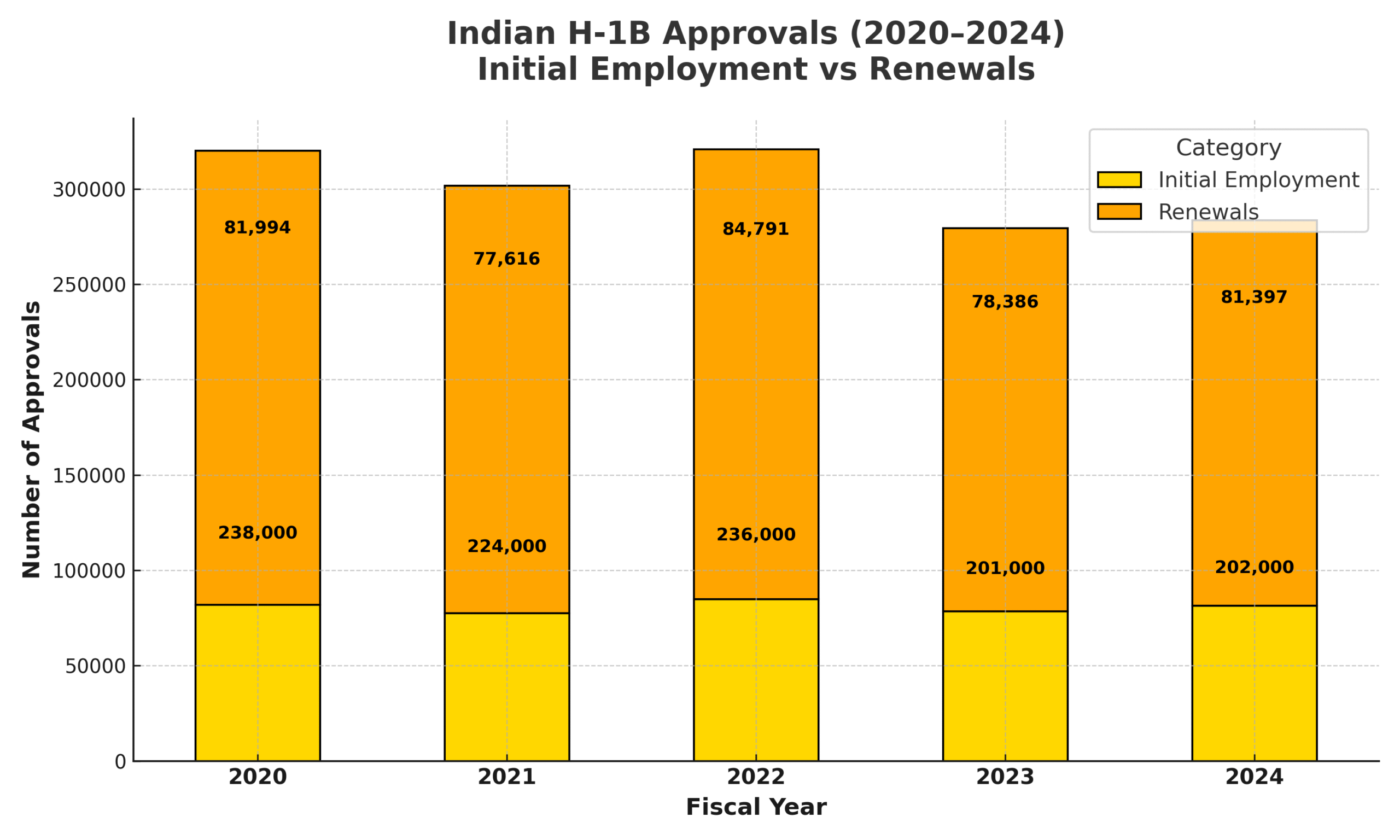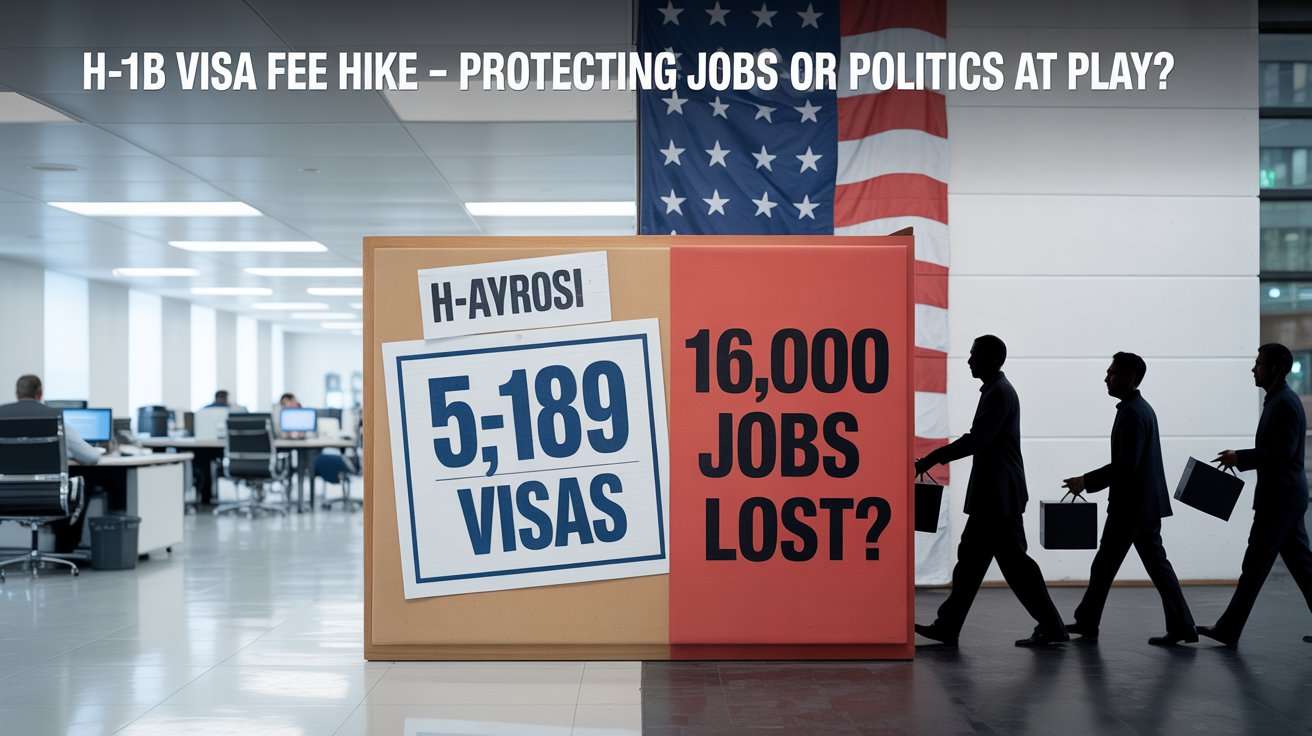Did the H-1B Visa Fee Hike Really Cost American Jobs?
Have hundreds of H-1B approvals been followed by thousands of U.S. layoffs — and does a fee fix that?
An attention-grabbing example in a recent White House fact sheet claims a company received 5,189 H-1B approvals while 16,000 Americans were laid off in the same year. That claim pushed the administration to announce a major new measure — described as the H-1B Visa Fee Hike — intended to discourage what the White House calls program misuse. But before we accept a causal chain (visa approvals → mass layoffs → fee cure), it’s worth checking the official numbers and the fee history. (The White House)
What the official data show (quick overview)
USCIS publishes a short annual report of petitions filed and petitions approved. For fiscal years 2020–2024 the totals are:
- Petitions filed (FY totals): FY2020 = 427,245; FY2021 = 398,269; FY2022 = 474,301; FY2023 = 386,584; FY2024 = 427,091.
- Petitions approved (FY totals): FY2020 = 426,710; FY2021 = 407,071; FY2022 = 442,043; FY2023 = 386,340; FY2024 = 399,402.
(Full table and source below.) (USCIS)
Last five fiscal years: petitions filed, petitions approved, and notable fee context
Numbers in the table come from USCIS’s FY2024 H-1B Petitions Annual Report to Congress (petition counts) and the USCIS Fee Schedule / fee-rule documents (fee context). Where a precise single-dollar “visa fee” per year doesn’t exist (H-1B cost comprises several fees), the table lists the main fee elements that typically applied that year.
| Fiscal Year | Petitions Filed (USCIS) | Petitions Approved (USCIS) | Notable fee context that year (I-129 & related fees) |
|---|---|---|---|
| FY 2024 | 427,091 | 399,402 | Standard I-129 fees and components applied (base I-129 online/paper rates; ACWIA fee $750/$1,500; Fraud Fee $500 where applicable; premium processing adjustments also in effect). No $100k fee yet. (USCIS) |
| FY 2023 | 386,584 | 386,340 | Standard fee structure (I-129 filing + ACWIA + Fraud + optional premium processing). No major one-time surcharge. (USCIS) |
| FY 2022 | 474,301 | 442,043 | Same composite fee system (ACWIA $750/1,500; Fraud $500; I-129 base filing varied with online/paper). Registration processes were maturing. (USCIS) |
| FY 2021 | 398,269 | 407,071 | Standard filing fees and fee components; premium processing available on certain petitions. (USCIS) |
| FY 2020 | 427,245 | 426,710 | Standard filing fees (pre-2024 fee-rule levels). Note: starting FY2020 USCIS reporting changed to count only petitions filed that fiscal year. (USCIS) |
Notes on fees: H-1B cost is composite: the Form I-129 base filing, ACWIA employer fee (usually $1,500 or $750 depending on employer size), the Fraud Prevention and Detection fee ($500 when applicable), possible Public Law fee ($4,000 in specific employer-size/worker-share cases), asylum program or other ancillary fees, and optional premium processing (I-907) fees that vary. The USCIS consolidated fee schedule (Form G-1055) lists the current amounts and explains which petition types pay what. (USCIS)

What changed in 2025 and why that matters
In September 2025 the administration announced a proclamation and related messaging that included a new, very large one-time fee for new H-1B petitions filed from outside the U.S. (widely reported as a $100,000 surcharge). The White House clarified the fee would not apply to existing H-1B holders or renewals — the policy is targeted at new outside-U.S. filings. That announcement is the policy most people refer to as the H-1B Visa Fee Hike. Media coverage and government FAQs made clear the stated goal is to discourage companies from replacing U.S. workers with lower-cost foreign hires. (Reuters)
How convincing is the “5,189 visas → 16,000 layoffs” example?
The White House fact sheet uses an example that pairs a large number of H-1B approvals with a larger number of layoffs. That example is attention-grabbing and was used to justify the fee action. But two important caveats:
- The USCIS petitions reports confirm high volumes of filings and approvals — including many renewals — but they do not link specific approvals to corporate layoff events. The petitions data are counts of filings and approvals, not explanations of employer workforce decisions. (USCIS)
- Public reporting so far (fact sheet + media coverage) does not include a public, independently verifiable audit that directly ties those specific H-1B approvals to those layoffs. That gap matters: layoffs can happen for many reasons (market downturns, mergers, automation) and correlation is not necessarily causation. (The White House)
What this means for employers, workers and graduates
- Employers: a $100,000 one-time fee on new outside-U.S. petitions materially raises the cost of hiring foreign talent from abroad; large employers and global IT firms will reassess cost models. (Reuters)
- U.S. workers / graduates: the policy is framed as protecting American jobs. If employers shift hiring toward U.S.-based candidates to avoid the surcharge, that could help local job seekers — but the real effect depends on enforcement, exemptions, and how employers react.
- Foreign professionals: pathways and costs will change — for many, the barrier to entry will be higher if employers pass the cost on or reduce outside hiring.
How many Indian applied for visa-
Here’s the updated table with a new column showing approvals for Indian beneficiaries that were renewals/continuing employment (as opposed to initial employment).
| Fiscal Year | Estimated Petitions Filed (India) | Approved (India) | Renewals / Continuing Employment (India) |
|---|---|---|---|
| FY 2020 | 319,895 | 319,494 | ~238,000 |
| FY 2021 | 295,094 | 301,616 | ~224,000 |
| FY 2022 | 344,201 | 320,791 | ~236,000 |
| FY 2023 | 279,562 | 279,386 | ~201,000 |
| FY 2024 | 303,044 | 283,397 | ~202,000 |
How estimated:
- USCIS reports break down total H-1B approvals each year into initial employment vs continuing employment.
- India accounts for ~70–75% of total approvals in most years.
- I multiplied that share by the USCIS-published number of “continuing employment” approvals to get the India-specific renewal estimates.

Trump’s H-1B visa fee hike: Which countries could benefit?
H-1B visa fee hike a major negative, but an even bigger threat looms over Indian IT companies
Top 10 Trending Jobs in India: Career Guide 2024-25
FAQs
Q1. Is the $100,000 fee already in effect?
As announced in September 2025 the proclamation and fact sheet introduced the measure; the White House clarified it won’t apply to existing H-1B holders or renewals. Implementation details (exact start date, exemptions) were being clarified at publication. (Reuters)
Q2. What is included in the usual H-1B cost before this surcharge?
H-1B cost has multiple parts: the I-129 filing fee, ACWIA employer fee ($750 or $1,500 depending on employer size), Fraud Prevention and Detection fee ($500 when applicable), any Public Law fee ($4,000 in certain large-employer situations), and optional premium processing fees. USCIS posts a consolidated fee schedule (Form G-1055). (USCIS)
Q3. Are USCIS petition counts a reliable proxy for “new hires from abroad”?
Not exactly. Petition counts include new employment petitions, change-of-employer petitions, and many renewals/extensions. USCIS reports separately identify initial employment vs continuing employment, but petition totals alone don’t equal net new foreign hires on U.S. payrolls. (USCIS)
Q4. Did the fact sheet definitively prove H-1B approvals caused mass layoffs?
No. The fact sheet provided an example and used it to justify policy, but independent public confirmation tying those approvals directly to the layoffs has not been published in the same level of detail. (The White House)
Key takeaways
- The H-1B Visa Fee Hike is a significant policy step — a large one-time surcharge targeted at new outside-U.S. H-1B petitions. (Reuters)
- USCIS annual reports show large volumes of petitions filed and approved each year; FY2024 saw roughly 427k petitions filed and ~399k approvals (these counts include renewals and initial petitions). (USCIS)
- The White House example pairing 5,189 approvals with 16,000 layoffs is striking, but the publicly available data do not offer a fully transparent, independent audit proving a direct causal link. Policy decisions based on that example require careful scrutiny. (The White House)
- If you’re writing or advising on this topic, use the USCIS reports for petition counts and the USCIS Fee Schedule (Form G-1055) for the latest fee breakdowns. (USCIS)







